|
Historical Information

Bete Grise Bay is located on the
south shore of Keweenaw Point, and had long served as a natural harbor
of refuge for vessels seeking to escape the fury of Superior's late
season nor'-westers. Entry into the bay was open to up bound vessels,
however down bound captains were forced to navigate the hazardous two
and a half mile wide passage between the western tip of the point and
Manitou Island before making south into the safety of the bay.
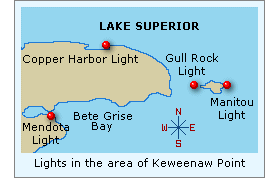 While
the Manitou Light was one of the first tree Lights to be built on
Superior in 1849, its location on the northeast extremity of the island
was designed to serve the regular line of navigation, and did little to
serve vessels making the emergency passage into Bete Grise. To make
matters worse, a number of shoals and rocky outcroppings peppered the
passage, the most dangerous of which was Gull Rock, located a half mile
off the western shore of Manitou Island. Two hundred and fifty feet in
length and one hundred feet in width, the highest point of Gull Rock
stood less than twelve feet above the water under the calmest
conditions, becoming virtually invisible in the gray darkness of stormy
days when vessels were most likely to be threading their way through the
passage. While
the Manitou Light was one of the first tree Lights to be built on
Superior in 1849, its location on the northeast extremity of the island
was designed to serve the regular line of navigation, and did little to
serve vessels making the emergency passage into Bete Grise. To make
matters worse, a number of shoals and rocky outcroppings peppered the
passage, the most dangerous of which was Gull Rock, located a half mile
off the western shore of Manitou Island. Two hundred and fifty feet in
length and one hundred feet in width, the highest point of Gull Rock
stood less than twelve feet above the water under the calmest
conditions, becoming virtually invisible in the gray darkness of stormy
days when vessels were most likely to be threading their way through the
passage.
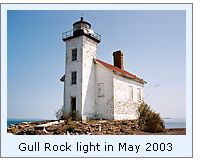 Michigan Sixth District Representative
John Fletcher Driggs presented a petition of Michigan citizens praying
for the construction of a lighthouse on Gull Rock before Congress on
January 17, 1865. After consideration and approval by the Lighthouse
Board and the Department of Commerce, Congress approved an appropriation
of $15,000 for the project on July 29 of the following year. Michigan Sixth District Representative
John Fletcher Driggs presented a petition of Michigan citizens praying
for the construction of a lighthouse on Gull Rock before Congress on
January 17, 1865. After consideration and approval by the Lighthouse
Board and the Department of Commerce, Congress approved an appropriation
of $15,000 for the project on July 29 of the following year.
Since Eleventh District construction
crews were already scheduled to be in the vicinity during the 1867
season of navigation for the construction of the identical Lights on Huron
Island and Granite Island,
the district engineer in Detroit determined that the cost of the new
light could be significantly reduced if the same structure design and
construction crew were employed on the Gull Rock construction project.
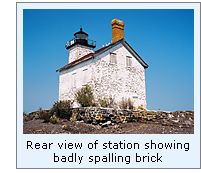 Work on Gull Rock began at the opening
of the 1867 navigation season, with planned completion by early fall.
However the unfortunate drowning death of construction foreman William
Tunbridge while working on the rock, caused a delay in construction
until a new foreman could be selected. Construction began with the
laying of a stone foundation upon which the 1 ½ story, 2,408 square
foot Cream
City brick keepers dwelling slowly took shape. The attached
brick tower contained a spiral iron staircase, which served both
dwelling floors as well as providing access to the lantern. The tower
was capped with a prefabricated octagonal cast iron lantern, with its
ventilator ball standing 46 feet above the building's foundation. The
lantern was equipped with a fixed red Fourth
Order Fresnel lens. With a focal plane of 50 feet, it was
calculated that the light would be visible for a distance of 13 ¼ miles
in clear weather. A brick privy, a boat landing and a series of
connecting concrete sidewalks completed the sparse station's complement
of structures. Thomas Jackson was appointed as Gull Rock's first keeper,
and after arriving at the station he exhibited the light for the first
time on the night of November 1, 1867. Work on Gull Rock began at the opening
of the 1867 navigation season, with planned completion by early fall.
However the unfortunate drowning death of construction foreman William
Tunbridge while working on the rock, caused a delay in construction
until a new foreman could be selected. Construction began with the
laying of a stone foundation upon which the 1 ½ story, 2,408 square
foot Cream
City brick keepers dwelling slowly took shape. The attached
brick tower contained a spiral iron staircase, which served both
dwelling floors as well as providing access to the lantern. The tower
was capped with a prefabricated octagonal cast iron lantern, with its
ventilator ball standing 46 feet above the building's foundation. The
lantern was equipped with a fixed red Fourth
Order Fresnel lens. With a focal plane of 50 feet, it was
calculated that the light would be visible for a distance of 13 ¼ miles
in clear weather. A brick privy, a boat landing and a series of
connecting concrete sidewalks completed the sparse station's complement
of structures. Thomas Jackson was appointed as Gull Rock's first keeper,
and after arriving at the station he exhibited the light for the first
time on the night of November 1, 1867.
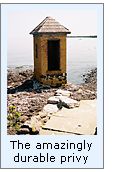 With
the primitive living conditions and the limited space
afforded by life on the rock, Gull Island
was considered one of the most isolated and difficult stations on the
Great Lakes. With no fog signal to tend there was little to do beyond
the mandatory morning lens, lantern and lamp maintenance. While there
was barely sufficient work to keep one man busy, both a keeper and
assistant were assigned to the station, likely more to provide
companionship than to share the workload. Even so, the turnover rate for assistant
keepers was abnormally high. To ease the situation, the district
inspectors approved the appointment of a number of keepers wives to the
position of assistant over the years. In this manner, Keeper James
Corgan's wife Mary served as his assistant for all six years during
which Corgan was keeper at The Rock from 1877 through 1883. With
the primitive living conditions and the limited space
afforded by life on the rock, Gull Island
was considered one of the most isolated and difficult stations on the
Great Lakes. With no fog signal to tend there was little to do beyond
the mandatory morning lens, lantern and lamp maintenance. While there
was barely sufficient work to keep one man busy, both a keeper and
assistant were assigned to the station, likely more to provide
companionship than to share the workload. Even so, the turnover rate for assistant
keepers was abnormally high. To ease the situation, the district
inspectors approved the appointment of a number of keepers wives to the
position of assistant over the years. In this manner, Keeper James
Corgan's wife Mary served as his assistant for all six years during
which Corgan was keeper at The Rock from 1877 through 1883.
According to the logbook entries of
John Nolan who served as Keeper from April 1897 to May 1903, water
in the passage usually began to ice over around the first week in
December each year, and the Light was extinguished for the winter, and
Nolan gingerly made his way to winter quarters in Copper
Harbor. As the ice began to break toward the end of April, he
returned to take up residence in the station. Although the entire
building was cold and damp, and the illuminating apparatus dirty, Nolan
reported that he usually managed to have the light illuminated on the
same day as his return to the station.
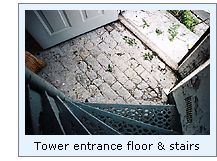 By virtue of its exposed location, one
would assume that the Gull Rock Light would have required constant
maintenance. However, Lighthouse Board annual reports on work performed
at the station would indicate otherwise, with few major repairs reported
over the entire active life of the station. By virtue of its exposed location, one
would assume that the Gull Rock Light would have required constant
maintenance. However, Lighthouse Board annual reports on work performed
at the station would indicate otherwise, with few major repairs reported
over the entire active life of the station.
After successful installation of fog
signal plants at Marquette
Harbor, Skillagallee,
South Manitou,
Outer Island and Huron
Island, in 1873 the Lighthouse Board requested an
appropriation for the construction of such a plant at Gull Rock, however
the station was never so equipped. 1883 saw the replacement of the
station's concrete walkways, and a 29 foot long boat landing was
constructed on the south side of the rock in 1890, along with various
minor repairs.
 Superior has always been famous for its
violent November storms, and 1892 was no exception, when on November 7th
the Canadian 3-masted schooner barge G M NEELON broke away from the tow
of the steamer S L TILLEY and struck the rock in heavy seas. While the
vessel was abandoned and considered to be a total loss, she was
recovered by the wrecker J H GILLETT a year later, and after repairs was
placed back into service. Superior has always been famous for its
violent November storms, and 1892 was no exception, when on November 7th
the Canadian 3-masted schooner barge G M NEELON broke away from the tow
of the steamer S L TILLEY and struck the rock in heavy seas. While the
vessel was abandoned and considered to be a total loss, she was
recovered by the wrecker J H GILLETT a year later, and after repairs was
placed back into service.
 The lighthouse tender AMARANTH
delivered the materials and a work crow to construct an oil storage
building in 1896, and two years later a work crew arrived to reconstruct
the boat landing which had been damaged by ice. In his log for October
12th of 1898 keeper Nolan recorded that "the men could not work at
the boat ways today, as the sea was coming up to the boat house door and
spray was flying across the rock." That same year, eighteen
improved Fourth Order lamps were delivered at the Detroit depot, one of
which was installed at Gull Rock. The lighthouse tender AMARANTH
delivered the materials and a work crow to construct an oil storage
building in 1896, and two years later a work crew arrived to reconstruct
the boat landing which had been damaged by ice. In his log for October
12th of 1898 keeper Nolan recorded that "the men could not work at
the boat ways today, as the sea was coming up to the boat house door and
spray was flying across the rock." That same year, eighteen
improved Fourth Order lamps were delivered at the Detroit depot, one of
which was installed at Gull Rock.
 As a result of frequent pounding by the
waves, a 40 foot long retaining wall of
rubble masonry at the northeast corner of the dwelling in 1901, with a coping of
Portland cement added to ensure durability and effectiveness as a
barrier to water penetration. The boat landing was once again rebuilt,
and a sixty foot stone filled protecting crib constructed to help keep
ice away from the landing. As a result of frequent pounding by the
waves, a 40 foot long retaining wall of
rubble masonry at the northeast corner of the dwelling in 1901, with a coping of
Portland cement added to ensure durability and effectiveness as a
barrier to water penetration. The boat landing was once again rebuilt,
and a sixty foot stone filled protecting crib constructed to help keep
ice away from the landing.
September 16, 1912 saw the second wreck
on Gull Rock. In an attempt to escape a real gut-buster of a storm on
the big, the 312 foot steel bulk freighter Spokane drove straight onto
the rock and broke clean in two. As was the case with the Neelon ten
years previous, while the Spokane was declared a total loss, she was
subsequently recovered and rebuilt, and continued to ply the lakes for
23 years until she was scrapped in 1935.
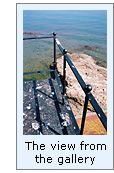 1913 was a particularly eventful year
at Gull Rock. On June 25th an acetylene illumination system was
installed in the fourth order lens. Equipped with a sun valve, the lamp
was automatically turned on at dusk and extinguished after dawn. At this
time the characteristic of the light was also changed from fixed red to
flashing red every 3 seconds and the intensity increased from 130 to 180
candlepower. The installation of a large acetylene tank allowed the
light to operate untended for long periods of time. With a resident
keeper no longer necessary to tend the light, management of the Gull
Rock light was turned over to the keepers of the Manitou Light, and Gull
Rock was secured and largely abandoned. 1913 was a particularly eventful year
at Gull Rock. On June 25th an acetylene illumination system was
installed in the fourth order lens. Equipped with a sun valve, the lamp
was automatically turned on at dusk and extinguished after dawn. At this
time the characteristic of the light was also changed from fixed red to
flashing red every 3 seconds and the intensity increased from 130 to 180
candlepower. The installation of a large acetylene tank allowed the
light to operate untended for long periods of time. With a resident
keeper no longer necessary to tend the light, management of the Gull
Rock light was turned over to the keepers of the Manitou Light, and Gull
Rock was secured and largely abandoned.
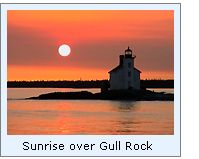 On November 8th, the 450 foot steel
hulled bulk freighter L C WALDO, fully loaded with iron ore was driven
ashore by a huge gale, ending up on Gull Rock. The Copper Harbor
lifesavers struggled heroically for four days to successfully rescue all
of her crew members. While she too was quickly declared a total loss,
she was later removed and rebuilt, and was sold into Canadian ownership.
The vessel subsequently moved into international trade, and ended up
sinking near Portofino, Italy while being towed to a scrap yard in
LaSpezia. On November 8th, the 450 foot steel
hulled bulk freighter L C WALDO, fully loaded with iron ore was driven
ashore by a huge gale, ending up on Gull Rock. The Copper Harbor
lifesavers struggled heroically for four days to successfully rescue all
of her crew members. While she too was quickly declared a total loss,
she was later removed and rebuilt, and was sold into Canadian ownership.
The vessel subsequently moved into international trade, and ended up
sinking near Portofino, Italy while being towed to a scrap yard in
LaSpezia.
Today, the Gull Rock Light still
guides mariners through the passage, its illumination provided by a
solar powered 12 volt DC 250 mm acrylic
optic. At some time the Fourth
Order lens was removed from the lantern and while it is reportedly on
display at the Whitefish
Point Light Station, recent evidence indicates that the lens
displayed lens in the museum came from the old iron skeleton tower which
was located on Gull Island to the west of the Beaver archipelago in Lake
Michigan.
The lighthouse was excessed through the National
Lighthouse Preservation Act in 2002, and in 2004 an individual who owns
property in the area partnered with the Michigan Lighthouse Foundation
to form
Gull Rock
Lightkeepers to apply for ownership of the station. The group
received ownership of the station in in June 2005, and is undertaking
the arduous task of stabilizing and restoring the station to serve
as a retreat for writers and artists.

Keepers of
this Light

Click here
to see a complete listing of all Gull Rock Light keepers compiled by
Phyllis L. Tag of Great Lakes Lighthouse Research.

Seeing this Light

Sand Point Charters out of La La Belle offers lighthouse cruises by
Mendota, Gull Rock and Manitou Island. For more information visit their website,
or telephone Sand Point Charters at (906) 370-2257.

Contact Information

Gull Rock Lightkeepers
Website:
www.gullrocklightkeepers.org
Email:
info@gullrocklightkeepers.org

Reference Sources

Congressional Record, 1865
Annual reports of the Lighthouse Board, various 1867 to 1903
Annual reports of the Lake Carriers Association, various 1903 to 1927
Lighthouse Digest, August 1999 & July 2000.
Gull Rock station log for 1883
The Great Lakes Shipwreck database, Dave Swayze.
August 2000 photograph courtesy of Alex Protzel
Keeper listings for this light appear
courtesy of Great
Lakes Lighthouse Research
|
